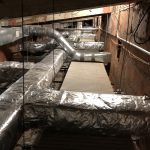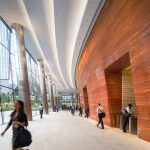How Does Engineering Encourage Sustainability?
“In 1949, the U.S. obtained 91% of its energy from fossil fuels. Despite the emergence of nuclear power and the growth of renewable sources, in 2017 the nation still relied on fossil fuels for 80% of its energy needs.”
– As reported by the United States Environmental Protection Agency (EPA) in 2018[1]
What is Sustainability?
Sustainability literally means “capable of being sustained.” In the context of the environment, this is about using natural resources responsibly to keep them from being depleted to the point of being completely lost. This requires a delicate balancing act on the part of humanity, taking what is needed, while replacing it with seeds for the future. This careful balance is supported by people all over the world and in a variety of ways, such as companies who plant a tree for every one they chop down.
The architecture and engineering industry plays a vital role in preserving the environment today and encouraging sustainability for the future. Energy and water are two resources that come up most often in sustainability conversations because of their importance in everyday life, and especially in buildings. Fortunately, today’s engineers are able to use a variety of methods and standards to help them design extremely efficient building systems.
Guides such as LEED, net zero, and WELL provide a way to set the bar for efficiency in building systems, keep building owners and managers accountable for their part in sustainability, and encourage occupant health.
What is LEED?
According to the U.S. Green Building Council, “LEED (Leadership in Energy and Environmental Design) is the most widely used green building rating system in the world. Available for virtually all building types, LEED provides a framework for healthy, highly efficient, and cost-saving green buildings.”[2]
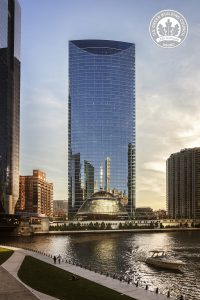
River Point, photo by David Sundberg/Esto.
Renovations and new construction projects can receive points depending on the sustainable products, systems, and processes used throughout design and construction. These points are then added up on a scorecard to evaluate what level the project has achieved: LEED Certification, LEED Silver, LEED Gold, or LEED Platinum. To help navigate LEED requirements, LEED Accredited Professionals (LEED APs), utilize their expertise in green building design to assist building owners, architects, and other team members in implementing economical and efficient solutions.
One example of a sustainable system can be found in Chicago, Illinois’ River Point project, a 1.1-million-square-foot tower and overbuild. To reduce water consumption, the engineering team at Alvine Engineering designed a system that collects the stormwater that lands on the site and pipes it to a cistern where the water is filtered and treated to meet the Illinois Department of Health standards. This water is then used to provide irrigation to the site, which includes a 1.5 acre park – the largest riverfront park in the city of Chicago. Overall, the water systems used throughout River Point save 1.5 to 2 million gallons of water annually and contribute to the achievement of LEED Platinum Certification.
What is Net Zero?
A net zero building design strategy involves balancing the resources consumed by a building’s systems with the resources produced on-site. As Douglas Alvine, P.E., LEED AP, President of Alvine Engineering, summarizes, “The key common element of net zero is reducing energy consumption within the built environment, from off-site and on-site carbon-based energy sources, to zero.” A combination of systems and solutions can be used together to achieve this equalization.
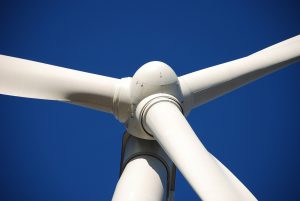 Creating a net zero building can be broken down into two basic steps: reduce the amount of energy used in the building as much as possible and then address this remaining energy use with on-site renewable energy generation. A building can increase energy efficiency in a variety of ways from more efficient construction, systems, and appliances to operations and maintenance. Even the behavior of building occupants impacts the efficiency of a building. Different renewable energy options, including wind, solar, and hydro energy, may be available to the building depending on the project site.
Creating a net zero building can be broken down into two basic steps: reduce the amount of energy used in the building as much as possible and then address this remaining energy use with on-site renewable energy generation. A building can increase energy efficiency in a variety of ways from more efficient construction, systems, and appliances to operations and maintenance. Even the behavior of building occupants impacts the efficiency of a building. Different renewable energy options, including wind, solar, and hydro energy, may be available to the building depending on the project site.
One example of net zero at work is the Central Community College (CCC) campus in Hastings, Nebraska. Alvine Engineering partnered with CCC and Bluestem Energy Solutions to develop a wind energy project that provides all of the energy for the CCC campus. The project also led to a partnership with the City of Hastings’ electrical utility to provide renewable energy to the customers served by the utility company. The final result established the Central Community College campus as the first 100% renewable energy campus in the State of Nebraska.
What is WELL?
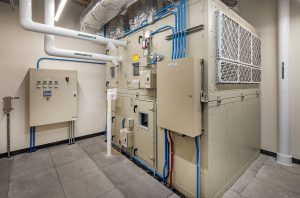
Alvine Engineering and IP Design Group Corporate Headquarters
The WELL Building Standard™ is complementary to the LEED system, taking it one step further to consider the health of the building occupants. WELL uses seven areas to design and track systems that truly result in positive changes for the occupants in addition to the environment. Much like LEED APs, WELL APs lend their expertise with WELL standards to their projects, helping the owner, architect, and other team members make informed decisions about the direction of design. To learn more about WELL and WELL APs, read “What is the WELL Building Standard?”
The Alvine Engineering and IP Design Group corporate headquarters is an example of a project designed to WELL standards. The underfloor air distribution system, for instance, is not only very efficient, but, when combined with activated carbon filtration and cleaning protocols, reduces the risk of transmitting illness. To find out how WELL-designed systems translate into a finished building, read “What Does a WELL-Designed Building Look Like?”
What About the Materials Used in Buildings?
The materials that comprise a building are also an important piece in overall sustainability. As Doug Alvine explains, embodied carbon, the amount of carbon emitted in the extraction of the raw materials and production of a building material, is currently gaining recognition as an area for improvement. Concrete, which is used in almost every type of building, has a relatively high embodied carbon value. Although steel structures are an improvement over concrete, using heavy timber structural materials is gaining popularity for both its lower carbon content and its architectural appeal.
“The emphasis on embodied carbon in the built environment is going to continue to gain importance,” Alvine continues. “Material production, as well as the selection of materials used, will be keys to developing buildings with significantly lower embodied carbon. A building’s embodied carbon footprint is a significant component of the true sustainability of the built environment.”
Where Can I Learn More?
Learn more about LEED and the U.S. Green Building Council by visiting https://www.usgbc.org/.
Find out more information about net zero through the World Green Building Council by visiting https://www.worldgbc.org/advancing-net-zero.
For more on WELL, visit https://www.wellcertified.com/.
For an example of a building embracing heavy timber, read the T3 Minneapolis Case Study featured on the Hines website.
Works Cited
[1] United States Environmental Protection Agency. (2018). Report on the Environment. United States Environmental Protection Agency.
[2] U.S. Green Building Council. (2020). Overview: What is LEED? Retrieved April 13, 2020, from U.S. Green Building Council LEED Website: https://www.usgbc.org/help/what-leed



